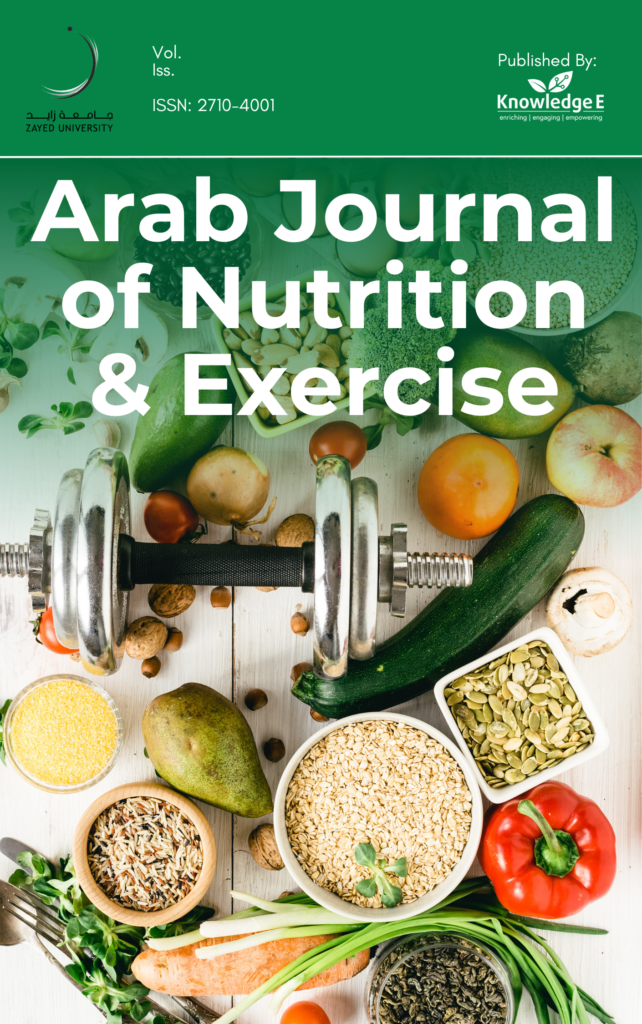
Arab Journal of Nutrition and Exercise
ISSN: 2518-6590
Groundbreaking research on nutrition, physical activity, and public health from across the Arab world.
Effects of Dietary Fiber Intake on Body Weight and Waist Circumference
Published date:Nov 12 2017
Journal Title: Arab Journal of Nutrition and Exercise
Issue title: AJNE: Vol 1, No 2 (2016)
Pages:77-84
Authors:
Abstract:
Aim: Obesity levels dramatically increased in the last decade in UAE. Diets high in energy, saturated fatty acids, low intake of fruits and vegetables as well as inactivity have been found to promote overweight and obesity. A diet high in fiber has been suggested to improve weight loss and decrease other anthropometrical indices. The purpose of this study was to assess the effect of a diet high in fiber on body weight, BMI, and waist circumference (WC).
Methods: One hundred forty overweight/obese subjects aged from 20-30 years old participated in the study. Body weight (BW), body mass index (BMI) and waist circumference (WC) was measured after one month period in which the subjects consumed diet high in dietary fiber (38 g/d/men, 25 g/d/women). SPSS was used for the analysis of data and statistically significant difference was set at P> 0.05.
Results: BW, BMI and WC were clinically reduced before and after intervention in both males and females. However, these changes were not statistically significant. Percent changes on BW for female and male subjects were 1.45 (95%CI: -12.68, 15.58), P>0.05 and 1.12 (95% CI: -13.58, 15.82), P>0.05, respectively.
Conclusion: The high fiber diet did not significantly reduce body weight and WC. Even though there was a small clinically reduction on BW, BMI and WC, however this was not statistically significant. The results, even though were not supportive, they should not discourage people from consuming foods high in fiber, due to other beneficial effects in their health such as decreasing the risk of cancer, lipidemia, type 2 diabetes and metabolic syndrome.
References:
[1] A. S. Beller, “Fat Thin: A Natural History of Obesity,” Farrar, Straus & Giroux, 1977.
[2] S. Wild, G. Roglic, A. Green, R. Sicree, and H. King, “Global prevalence of diabetes: estimates for the year 2000 and projections for 2030,” Diabetes Care, vol. 27, no. 5, pp. 1047–1053, 2004.
[3] C. L. Ogden, M. D. Carroll, B. K. Kit, and K. M. Flegal, “Prevalence of childhood and adult obesity in the United States, 2011-2012,” The Journal of the American Medical Association, vol. 311, no. 8, pp. 806–814, 2014.
[4] M. Saberi, UAE the fifth most obese country in the world, Gulf News, Dubai, 2012.
[5] A. O. Musaiger, M. Al-Mannai, R. Tayyem et al., “Prevalence of overweight and obesity among adolescents in seven Arab Countries: A cross-cultural study,” Journal of Obesity, vol. 2012, Article ID 981390, 2012.
[6] M. Malik and A. Bakir, “Prevalence of overweight and obesity among children in the United Arab Emirates,” Obesity Reviews, vol. 8, no. 1, pp. 15–20, 2007.
[7] A. Kerkadi, N. Abo-Elnaga, and W. Ibrahim, “Prevalence of overweight and associated risk factors among primary female school children in Al-Ain city, United Arab Emirates,” Emirates Journal of Food and Agriculture, vol. 17, no. 1, pp. 43–56, 2005.
[8] J. Snart, R. Bibiloni, T. Grayson et al., “Supplementation of the diet with highviscosity beta-glucan results in enrichment for lactobacilli in the rat cecum,” Applied and Environmental Microbiology, vol. 72, no. 3, pp. 1925–1931, 2006.
[9] P. Bjoerntorp, “Dietary fiber and obesity. Proceedings of a Satellite Symposium to the second Washington Symposium on Dietary Fibers,” Washington, DC, USA, 1984.
[10] S. M. Pilch, “Effect of one week of fibre supplementation on hunger and satiety ratings and energy intake,” in Physiological Effects and Health Consequences of Dietary Fiber. Life Sciences Research Office, pp. 149–157, MD, Bethesda, 1987.
[11] B. J. Rolls, “Effects of food quality, quantity, and variety on intake,” in Not Eating Enough, B. M. Marriott, Ed., pp. 203–215, National Academy Press, Washington, DC, 1995.
[12] S. S. Gropper and P. B. Acosta, “Brief communication: The therapeutic effect of fiber in treating obesity,” Journal of the American College of Nutrition, vol. 6, no. 6, pp. 533–535, 1987.
[13] J. L. Slavin, “Dietary fiber and body weight,” Nutrition Journal , vol. 21, no. 3, pp. 411–418, 2005.
[14] S. Liu, WC. Willet, JE. Manson, Hu. FB, B. Rosner, and G. Colditz, “Relation between changes in intakes of dietary fiber and grain products and changes in weight and development of obesity among middleaged women,” Am J Clin Nutr, vol. 78, no. 5, pp. 920–927, 2003.
[15] S. B. Roberts and M. B. Heyman, “Dietary composition and obesity: do we need to look beyond dietary fat,” J Nutr, pp. 130–267S, 2000.
[16] B. J. Rolls, J. A. Ello-Martin, and B. C. Tohill, “What Can Intervention Studies Tell Us about the Relationship between Fruit and Vegetable Consumption and Weight Management?” Nutrition Reviews, vol. 62, no. 1, pp. 1–17, 2004.